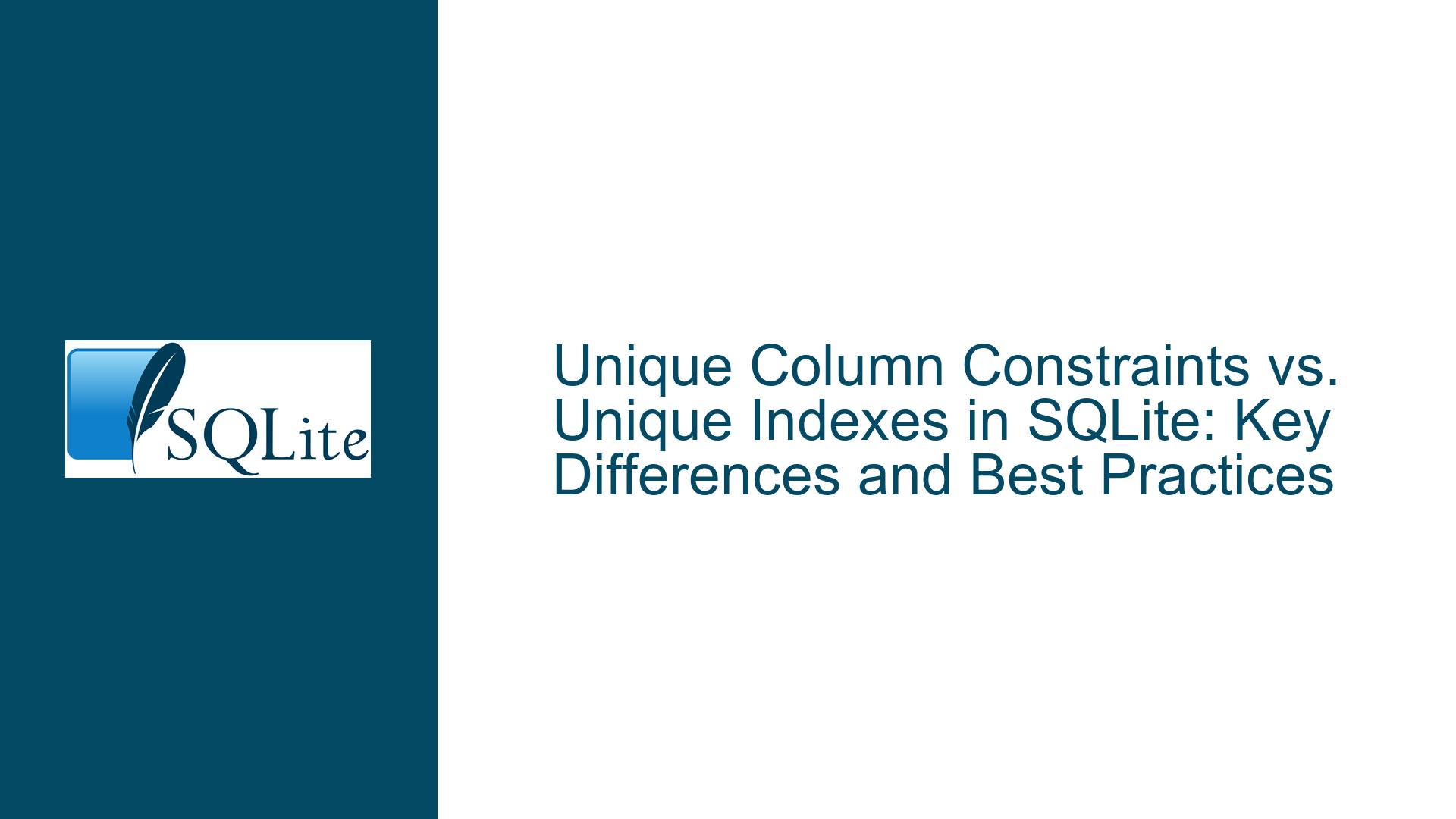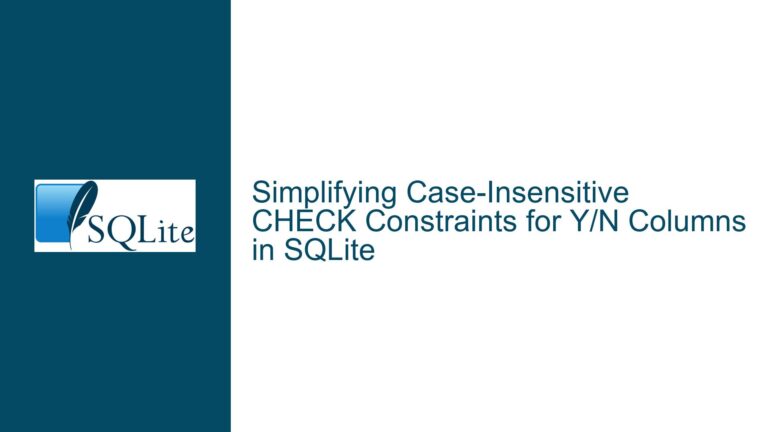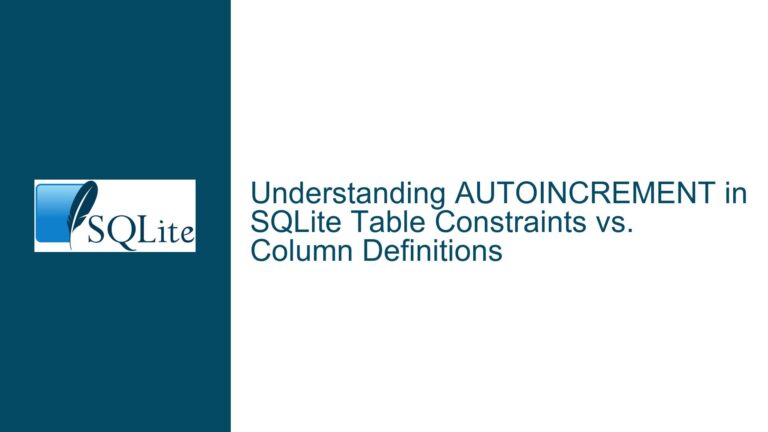Unique Column Constraints vs. Unique Indexes in SQLite: Key Differences and Best Practices
Unique Column Constraints and Unique Indexes: Functional Equivalence with Nuanced Differences
In SQLite, both unique column constraints and unique indexes serve the primary purpose of enforcing uniqueness on one or more columns within a table. At first glance, they appear to be interchangeable, and in many cases, they are functionally equivalent. However, subtle differences exist in their implementation, flexibility, and usage that can significantly impact database design, maintenance, and performance. Understanding these nuances is critical for making informed decisions when designing schemas or optimizing queries.
A unique column constraint is typically defined within the CREATE TABLE statement, directly specifying that a column or a combination of columns must contain unique values. For example, CREATE TABLE users (id INTEGER PRIMARY KEY, email TEXT UNIQUE); enforces that the email column must be unique across all rows in the users table. Under the hood, SQLite implements this constraint by automatically creating a unique index on the specified column(s). This implicit index is managed by SQLite and cannot be directly manipulated by the user.
On the other hand, a unique index is explicitly created using the CREATE UNIQUE INDEX statement. For example, CREATE UNIQUE INDEX idx_email ON users(email); achieves the same uniqueness enforcement as the unique column constraint but provides additional flexibility. Unlike the implicit index created by a unique constraint, an explicit unique index can be dropped, recreated, or modified independently of the table definition. This flexibility can be advantageous in scenarios where the uniqueness requirements evolve over time.
While both methods enforce uniqueness, they differ in their expressiveness and control. Unique column constraints are limited to bare columns and cannot include expressions or computed values. In contrast, unique indexes can enforce uniqueness on expressions, such as CREATE UNIQUE INDEX idx_lower_email ON users(LOWER(email));, which ensures uniqueness based on a case-insensitive comparison of email addresses. This capability makes unique indexes more versatile for complex uniqueness requirements.
Another key difference lies in the naming and management of the underlying indexes. Unique column constraints generate implicit indexes with system-defined names, which are not directly accessible or modifiable by the user. Explicit unique indexes, however, allow developers to assign meaningful names and manage them independently. This distinction becomes particularly important during database maintenance, such as when rebuilding indexes or migrating schemas.
Limitations of Unique Column Constraints and Advantages of Unique Indexes
The primary limitation of unique column constraints is their lack of flexibility compared to explicit unique indexes. Since unique constraints are tied to the table definition, they cannot be modified or dropped without altering the table schema. This rigidity can pose challenges in dynamic environments where uniqueness requirements may change over time. For instance, if a column initially requires uniqueness but later needs to allow duplicates, the only way to remove the constraint is to recreate the table or use a series of complex schema migration steps.
Unique indexes, on the other hand, offer greater control and adaptability. They can be created, dropped, or modified at any time without affecting the table structure. This flexibility is particularly valuable in scenarios where uniqueness requirements are subject to change, such as when transitioning from a single-column uniqueness constraint to a multi-column one. For example, if the users table initially enforces uniqueness on the email column but later needs to enforce uniqueness on the combination of email and username, an explicit unique index can be easily redefined without altering the table schema.
Another advantage of unique indexes is their ability to enforce uniqueness on expressions or computed values. This capability is not available with unique column constraints, which are limited to bare columns. For example, a unique index can enforce uniqueness on a combination of columns or a transformed version of a column, such as a lowercased or trimmed value. This feature is particularly useful for implementing case-insensitive uniqueness or other domain-specific rules.
Additionally, unique indexes provide more control over index naming and management. Explicit indexes can be assigned meaningful names, making them easier to identify and manage during database maintenance. In contrast, the implicit indexes created by unique constraints have system-generated names, which can be difficult to track and manage, especially in large databases with numerous constraints.
Implementing Unique Constraints and Indexes with ON CONFLICT Handling
One of the most powerful features of SQLite is its support for conflict resolution during insert operations. Both unique column constraints and unique indexes can be used in conjunction with the ON CONFLICT clause to specify how conflicts should be handled when a uniqueness violation occurs. However, there are subtle differences in how these mechanisms interact with the ON CONFLICT clause.
The ON CONFLICT clause allows developers to define specific actions to take when a conflict arises, such as ignoring the conflicting row, replacing it, or aborting the operation. For example, INSERT INTO users(email) VALUES('[email protected]') ON CONFLICT(email) DO NOTHING; ensures that the insert operation does not fail if a row with the same email already exists. This behavior is supported for both unique column constraints and unique indexes, as long as the conflict arises from a uniqueness violation.
However, the ON CONFLICT clause must be explicitly specified in the INSERT statement and cannot be predefined at the index or constraint level. This means that the conflict resolution strategy must be defined each time an insert operation is performed, regardless of whether the uniqueness is enforced by a constraint or an index. While this approach provides flexibility, it also requires careful attention to ensure consistent behavior across all insert operations.
In practice, the choice between unique constraints and unique indexes often comes down to the specific requirements of the application and the desired level of control. Unique constraints are ideal for simple, static uniqueness requirements that are unlikely to change over time. They provide a concise and declarative way to enforce uniqueness within the table definition. Unique indexes, on the other hand, offer greater flexibility and control, making them better suited for dynamic or complex uniqueness requirements.
When implementing unique constraints or indexes, it is important to consider the performance implications of each approach. Both methods rely on underlying indexes to enforce uniqueness, which can impact insert, update, and delete operations. However, explicit unique indexes provide more opportunities for optimization, such as using covering indexes to reduce the number of disk accesses or leveraging partial indexes to enforce uniqueness on a subset of rows.
In conclusion, while unique column constraints and unique indexes are functionally equivalent in many respects, they differ in their flexibility, expressiveness, and control. Understanding these differences is essential for making informed decisions when designing and maintaining SQLite databases. By carefully considering the specific requirements of the application and the desired level of control, developers can choose the most appropriate method for enforcing uniqueness and ensure optimal performance and maintainability.






